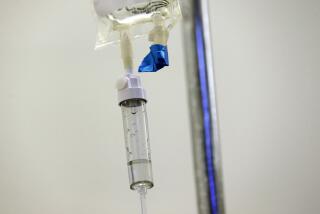U.S. Firm Agrees to Produce TB Drug : Health: Production is expected to end a two-year shortage of streptomycin sulfate. The medicine will be used to combat rising spread of the infection.
- Share via
WASHINGTON — A U.S. pharmaceutical company has agreed to produce an important tuberculosis drug that has been in critically short supply in this country for the last two years, federal health officials announced Monday.
The drug, streptomycin sulfate, which is given by injection, will be manufactured by Pfizer Inc., of New York, under a special application recently approved by the Food and Drug Administration.
Production should end a shortage that began in mid-1991 after the last U.S. manufacturer stopped producing the drug, the agency said.
“I am gratified by the way federal agencies and private industry cooperated to fill an important public health need,” Health and Human Services Secretary Donna E. Shalala said in a statement.
“The end of the streptomycin shortage shows that even major problems can be overcome by goal-oriented teamwork,” she added. “It’s the sort of spirit I’d like to see in action, again and again.”
The incidence of tuberculosis, which had been declining before 1985, has surged sharply in recent years, and is now regarded as a major public health problem.
Tuberculosis is a chronic bacterial infection that is spread through the air and usually affects the lungs. Worldwide, about 1.7 billion individuals are infected with dormant tuberculosis. About 8 million of them develop active infectious cases annually.
About 10 million Americans are believed to be infected with dormant TB.
In 1985, an all-time low total of 22,201 cases of active tuberculosis was reported to the federal Centers for Disease Control. In 1992, the total rose to 26,673 cases, an increase of 20% during the seven-year period and a 1.5% rise from the previous year.
In a report last week, the CDC, known now as the Centers for Disease Control and Prevention, said that there has been a worrisome increase in the number of cases among children younger than 5, meaning that they were infected recently.
The increase has been attributed to AIDS, which makes individuals more vulnerable to infectious diseases, including TB, and to dormant cases among immigrants to the United States. Immigration regulations bar entry only to individuals with active cases of TB, and do not apply to visitors.
Generally, tuberculosis is curable through combination drug therapy, but treatment must continue for up to a year. Problems can occur when patients fail to complete the necessary course of treatment, allowing the bacteria to survive and become resistant to the drugs.
Streptomycin sulfate is recommended as an addition to a core regimen of drugs, including isoniazid, rifampin and pryazinamide, to prevent the emergence of drug-resistant TB.
The shortage of streptomycin developed in part because the disease had been waning until recent years and because it had been considered a second-line treatment, the FDA said.
Also, the major European producer of the “bulk” drug product did not meet FDA’s standards for “good manufacturing practices,” and could not provide it to this country, the agency said.
When the shortage became apparent two years ago, the FDA established a special task force headed by Mary Pendergast, deputy commissioner of the agency, to canvass drug companies in the United States, Europe and Asia trying to identify a firm willing to seek approval to market the drug in this country.
At the same time, the agency allowed emergency imports of the drug from Canada.
“Tuberculosis is again on the rise, and Pfizer is to be commended for answering our call for an assured supply of therapies to curb this resurgence,” FDA Commissioner David A. Kessler said in a statement.
Margaret A. Hamburg, New York City health commissioner, said the arrangement was “a very positive thing in our efforts for tuberculosis control. Streptomycin is a tried and true drug, and we need every available tool we can have in this battle.”
New York city has nearly 4,000 cases of TB annually, Hamburg said, an increase of 140% since 1980 and more than three times the number recorded in Los Angeles, where incidence of the disease also has risen sharply.
TB’s Comeback
An all-time low of active tuberculosis cases was reported in 1985. Here are figures for the last 10 years.
Thousands of cases 1983: 23.8 1984: 22.3 1985: 22.2 1986: 22.8 1987: 22.5 1988: 22.4 1989: 23.5 1990: 25.7 1991: 26.3 1992: 26.7 Source: Centers for Disease Control and Prevention
More to Read
Sign up for Essential California
The most important California stories and recommendations in your inbox every morning.
You may occasionally receive promotional content from the Los Angeles Times.












